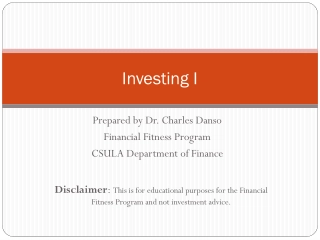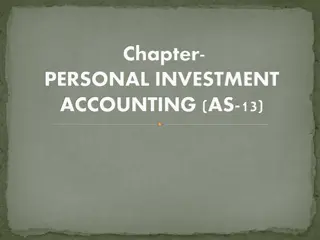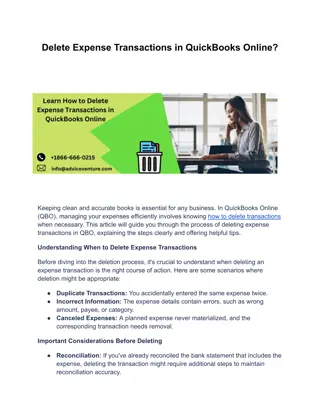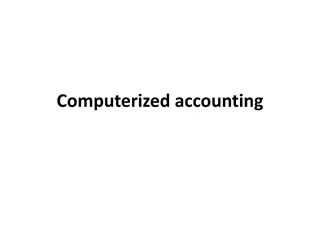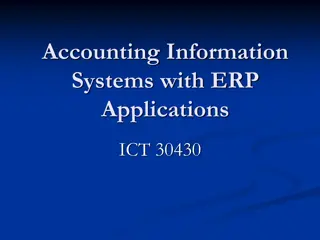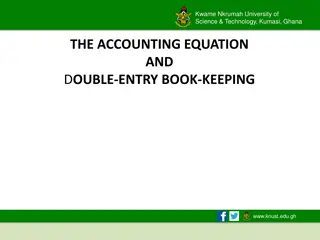Understanding Investment Accounts and Transactions in Financial Accounting
Investment accounts involve transactions such as purchasing and selling bonds, debentures, and stocks, with considerations for interest payments, market prices, and accrued interest. Differentiating between Ex-Interest and Cum-Interest transactions is crucial in determining the capital cost of investments. This summary provides insights into managing investment accounts effectively.
Download Presentation

Please find below an Image/Link to download the presentation.
The content on the website is provided AS IS for your information and personal use only. It may not be sold, licensed, or shared on other websites without obtaining consent from the author. Download presentation by click this link. If you encounter any issues during the download, it is possible that the publisher has removed the file from their server.
E N D
Presentation Transcript
B Com III Semester V Unit IV Investment Account Prof Sanjay Aswale , SHRI CHHATRAPATI SHIVAJI COLLEGE, OMERGA CONVENER Prof. Sanjay Aswale Vice Principal and Coordinator
Problem I On 1.1. 2019, Raj Ltd. bought 100, 12% Govt. Bonds of Rs. 1,000 each at Rs. 940 each. On 1.8.2019, X Ltd. sold 50, 12% Debentures at Rs. 980 each. Interest is paid half-yearly, i.e., on 30th, June and 31st December, every year. Prepare 12% Govt. Bonds Account assuming market price is Rs. 990 per bond.
In the Books of Raj Ltd. 12% Govt. Bond A/c (Interest Payable -30thJune and 31stDecember) Date Particular Face Inter Cost Date Particular Face Interes Cost Value est Price Value t Price To Bank 100000 - 94000 30-6- By Bank (Int) - 6000 - 01-01- (Purchase) 19 19 To P& L A/c 9000 01- By Bank 50000 -- 49000 31.12- 07-19 (Sold) 19 To P &L A/c 2000 31.12 By Bank (Int) -- 3000 -- 31.12. (Profit) -19 19 31.12 By Bal c/d 50000 47000 -19 100000 9000 96000 100000 9000 96000
Ex-Interest or Ex-Dividend: When the seller retains the right to receive the interest/dividend, the transaction is called Ex-Interest or Ex-dividend purchase or sale. In other words, when the price quoted is exclusive of accrued interest/dividend, the price so quoted is treated as the capital cost of investment, i.e., the buyer has to pay accrued interest due from the last interest date to the date of transaction to the seller along with the cost price of investment.
When Purchase and Sale of Investment before the date of payment of interest: So it necessary to think whether the quoted price of investment is inclusive of interest/dividend or exclusive of interest/dividend. To learn Cum-Interest and Ex-Interest. 1. Cum-Interest or Cum-Dividend: Where the right to receive interest or dividend from the issuer of security passes from the seller to the buyer, the transaction is known as Cum-Interest or Cum- Dividend purchase or sale. In other words, when the accrued interest or dividend from the last interest or dividend date up to the date of transaction is included in the quoted price, the capital cost of investment purchased or sold is ascertained by deducting the accrued interest/dividend from the quoted prices. And the difference between the quoted price and the actual cost may be represented as Cum-Interest or Cum-Dividend
For Example: On 15.3.2020 Osho Ltd. purchased Rs. 1,00,000, 9 per cent Govt. Stock (interest payable on 1st April, 1st July, 1st October and 1st January) at 88|cum-interest. On 1st August Rs. 20,000 stock is sold at 89 cum- interest and on 1st September Rs. 30,000 stock is sold at 88 Ex-interest. On 31st December, the date of the Balance Sheet, the market price was Rs. 90. Show the ledger account of the Investment for the year, ignoring Income Tax, Brokerage etc. and making apportionments in month.
In the Books of Osho Ltd. 12% Govt. Bond A/c (Interest payable on 1st April, 1st July, 1st October and 1st January) Date Particular Face Value Intere Cost Date Particular Face Interest Cost st Price Value Price 15-3-20 To Bank (Purchase) 86625 01.04.20 By Bank 100000 1875 -- 2250 - (Int) By Bank 01.08-20 To P& L A/c (profit) 125 01-07-20 -- 2250 49000 (Int) By Bank 01.09-20 To P &L A/c (Profit) 787 01-08-20 30000 450 26775 (Sold) 31.12- 20 To P &L A/c (Int) 01.10-20 By Bank ( 5475 -- 1125 -- Int) By Bal c/d 31.12.20 50000 1125 43312 100000 50000 7350 1125 85537 43312 100000 7350 85537 01-01.21 To bal b/d


